Interlingual Interactions Elicit Performance Mismatches Not “Compromise” Categories in Early Bilinguals: Evidence from Meta-Analysis and Coronal Stops
Abstract
:1. Introduction
1.1. Background and Motivation
1.2. Motivating Meta-Analysis
1.3. The Present Study
- What is the cumulative evidence for “compromise” categories?
- Is the effect modulated by linguistic factors, such as place of articulation, word position, or lexical stress?
- Do analytic techniques account for between-study variability?
- Is the “compromise” category literature sufficiently powered?
2. Meta-Analysis
2.1. Method
2.1.1. Study Identification and Screening
2.1.2. Eligibility
2.1.3. Coding
2.1.4. Statistical Analysis
2.2. Results
2.3. Interim Discussion
3. Production of Coronal Stops
3.1. Method
3.1.1. Participants
3.1.2. Materials
3.1.3. Measurements
3.1.4. Statistical Analysis
3.2. Results
3.2.1. VOT
3.2.2. Relative VOT
3.2.3. Bilingual Performance Mismatches
4. Discussion
5. Conclusions
Supplementary Materials
Funding
Institutional Review Board Statement
Informed Consent Statement
Data Availability Statement
Acknowledgments
Conflicts of Interest
References
- Amengual, Mark. 2012. Interlingual influence in bilingual speech: Cognate status effect in a continuum of bilingualism. Bilingualism 15: 517. [Google Scholar] [CrossRef] [Green Version]
- Antoniou, Mark, Catherine T. Best, Michael D. Tyler, and Christian Kroos. 2010. Language context elicits native-like stop voicing in early bilinguals’ productions in both L1 and L2. Journal of Phonetics 38: 640–53. [Google Scholar] [CrossRef] [PubMed] [Green Version]
- Antoniou, Mark, Catherine T. Best, Michael D. Tyler, and Christian Kroos. 2011. Inter-language interference in VOT production by L2-dominant bilinguals: Asymmetries in phonetic code-switching. Journal of Phonetics 39: 558–70. [Google Scholar] [CrossRef] [PubMed] [Green Version]
- Bohn, Ocke-Schwen. 2020. Cross-language phonetic relationships account for most, but not all L2 speech learning problems: The role of universal phonetic biases and generalized sensitivities. In Approaches to the Study of Sound Structure and Speech: Interdisciplinary Work in Honour of Katarzyna Dziubalska-Kołaczyk. London: Routledge, pp. 171–84. [Google Scholar]
- Brysbaert, Marc. 2020. Power considerations in bilingualism research: Time to step up our game. In Bilingualism: Language and Cognition. Cambridge: Cambridge University Press, pp. 1–6. [Google Scholar] [CrossRef]
- Bullock, Barbara. E., Alameida J. Toribio, Verónica González, and Amanda Dalola. 2006. Language dominance and performance outcomes in bilingual pronunciation. In Proceedings of the 8th Generative Approaches to Second Language Acquisition Conference. Somerville: Cascadilla Proceedings Project, pp. 9–16. [Google Scholar]
- Bürkner, Paul-Christian. 2017. brms: An R package for Bayesian multilevel models using Stan. Journal of Statistical Software 80: 1–28. [Google Scholar] [CrossRef] [Green Version]
- Caramazza, Alfonso, Grace H. Yeni-Komshian, Edgar B. Zurif, and Etorre Carbone. 1973. The acquisition of a new phonological contrast: The case of stop consonants in French-English bilinguals. The Journal of the Acoustical Society of America 54: 421–28. [Google Scholar] [CrossRef] [Green Version]
- Casillas, Joseph V., Yamile Díaz, and Miquel Simonet. 2015. Acoustics of Spanish and English coronal stops. Paper presented at 18th International Congress of Phonetic Sciences, Glasgow, UK, August 10–14; pp. 1–5. [Google Scholar]
- Chang, Charles B., Yao Yao, Erin F. Haynes, and Russell Rhodes. 2011. Production of phonetic and phonological contrast by heritage speakers of Mandarin. The Journal of the Acoustical Society of America 129: 3964–80. [Google Scholar] [CrossRef] [Green Version]
- Cho, Taehong, and Peter Ladefog. 1999. Variation and universals in VOT: Evidence from 18 languages. Journal of Phonetics 27: 207–29. [Google Scholar] [CrossRef]
- Chodroff, Eleanor, and Melissa Baese-Berk. 2019. Constraints on variability in the voice onset time of L2 English stop consonants. Paper presented at 19th International Congress of Phonetic Sciences, Melbourne, Australia, August 5–9; pp. 3348–3352. [Google Scholar]
- Chodroff, E., and C. Wilson. 2017. Structure in talker-specific phonetic realization: Covariation of stop consonant VOT in American English. Journal of Phonetics 61: 30–47. [Google Scholar] [CrossRef]
- Cohen, Jacob. 2013. Statistical Power Analysis for the Behavioral Sciences. London: Routledge. [Google Scholar]
- Ellis, Paul D. 2010. The Essential Guide to Effect Sizes: Statistical Power, Meta-Analysis, and the Interpretation of Research Results. Cambridge: Cambridge University Press. [Google Scholar]
- Escudero, Paola. 2005. Linguistic Perception and Second Language Acquisition. Ph.D. Thesis, Utrecht University, Utrecht, The Netherlands. [Google Scholar]
- Flege, James. E. 1991. Age of learning affects the authenticity of voice-onset time (VOT) in stop consonants produced in a second language. The Journal of the Acoustical Society of America 89: 395–411. [Google Scholar] [CrossRef]
- Flege, James. E. 1995. Second language speech learning: Theory, findings, and problems. In Speech Perception and Linguistic Experience Issues in Cross-Language Research. Edited by W. Strange. Timonium: York Press, pp. 229–73. [Google Scholar]
- Flege, James. E., and Wieke Eefting. 1987b. Production and perception of English stops by native Spanish speakers. Journal of Phonetics 15: 67–83. [Google Scholar] [CrossRef]
- Flege, James. E., and Wieke Eefting. 1988. Imitation of a VOT continuum by native speakers of English and Spanish: Evidence for phonetic category formation. The Journal of the Acoustical Society of America 83: 729–40. [Google Scholar] [CrossRef] [PubMed]
- Flege, James. E., and James Hillenbrand. 1984. Limits on phonetic accuracy in foreign language speech production. The Journal of the Acoustical Society of America 76: 708–21. [Google Scholar] [CrossRef]
- Fowler, Carol. A., Valery Sramko, David J. Ostry, Sarah A. Rowland, and Pierre Hallé. 2008. Cross language phonetic influences on the speech of French–English bilinguals. Journal of Phonetics 36: 649–63. [Google Scholar] [CrossRef] [PubMed] [Green Version]
- Gabriel, Christoph, Tanja Kupisch, and Jeanette Seoudy. 2016. VOT in French as a foreign language: A production and perception study with mono-and multilingual learners (German/Mandarin-Chinese). SHS Web Conf. 27: 1–14. [Google Scholar] [CrossRef]
- Gelman, Andrew, Daniel Simpson, and Michael Betancourt. 2017. The prior can often only be understood in the context of the likelihood. Entropy 19: 555. [Google Scholar] [CrossRef] [Green Version]
- Gertken, Libby M., Mark Amengual, and David Birdsong. 2014. Assessing Language Dominance with the Bilingual Language Profile. Edited by P. Leclercq, A. Edmonds and H. Hilton. Bristol: Multilingual Matters. [Google Scholar]
- Gonzales, Kalim, and Andrew J. Lotto. 2013. A Bafri, un Pafri: Bilinguals’ Pseudoword identifications support language-specific phonetic systems. Psychological Science 24: 2135–42. [Google Scholar] [CrossRef]
- Gonzales, Kalim, Krista Byers-Heinlein, and Andrew J. Lotto. 2019. How bilinguals perceive speech depends on which language they think they’re hearing. Cognition 182: 318–30. [Google Scholar] [CrossRef]
- Grosjean. 2001. The Bilingual’s Language Modes. In One Mind, Two Languages: Bilingual Language Processing. Edited by Janet Nicol. Oxford: Oxford University Press, pp. 1–22. [Google Scholar]
- Hazan, Valerie L., and Georges Boulakia. 1993. Perception and production of a voicing contrast by French-English bilinguals. Language and Speech 36: 17–38. [Google Scholar] [CrossRef]
- Holliday, Jeffrey J. 2015. A longitudinal study of the second language acquisition of a three-way stop contrast. Journal of Phonetics 50: 1–14. [Google Scholar] [CrossRef]
- Jones, Kyle. S. 2020. A Multigenerational Investigation of Voice Onset Time in English-Hebrew Heritage Speakers. Ph.D. Thesis, The University of Arizona, Tucson, AZ, USA. [Google Scholar]
- Kehoe, Margaret M., Conxita Lleó, and Martin Rakow. 2004. Voice onset time in bilingual German-Spanish children. Bilingualism 7: 71. [Google Scholar] [CrossRef]
- Kiliç, Mehmet. 2018. Voice onset time as an indicator of interlanguage: Evidence from Turkish-accented English. Journal of Language and Linguistic Studies 14: 272–84. [Google Scholar]
- Kilpatrick, Cynthia. D. 2004. Compromised VOT: Variation in a Bilingual Community. Ph.D. Thesis, University of Texas at El Paso, El Paso, TX, USA. [Google Scholar]
- Kruschke, John K. 2018. Rejecting or accepting parameter values in Bayesian estimation. Advances in Methods and Practices in Psychological Science 1: 270–80. [Google Scholar] [CrossRef] [Green Version]
- Kupisch, Tanja, and Conxita Lleó. 2017. Voice onset time in German-Italian simultaneous bilinguals: Evidence on cross-language influence and markedness. In Romance-Germanic Bilingual Phonology. Edited by M. S. Yavaş, M. Kehoe and W. Cardoso. Sheffield: Equinox, pp. 79–98. [Google Scholar]
- Lein, Tatjana, Tanja Kupisch, and Joost van de Weijer. 2016. Voice onset time and global foreign accent in German–French simultaneous bilinguals during adulthood. International Journal of Bilingualism 20: 732–49. [Google Scholar] [CrossRef] [Green Version]
- Lisker, Leigh, and Arthur. S. Abramson. 1964. A cross-language study of voicing in initial stops: Acoustical measurements. Word 20: 384–422. [Google Scholar] [CrossRef] [Green Version]
- Llama, Raquel, and Luz P. López-Morelos. 2016. VOT production by Spanish heritage speakers in a trilingual context. International Journal of Multilingualism 13: 444–58. [Google Scholar] [CrossRef]
- López, V. G. 2012. Spanish and English word-initial voiceless stop production in code-switched vs. Monolingual structures. Second Language Research 28: 243–63. [Google Scholar] [CrossRef]
- Lozano-Argüelles, Cristina, Laura Fernández Arroyo, Nicole Rodríguez, Ezequiel M. Durand López, Juan J. Garrido Pozú, Jennifer Markovits, Jessica Varela, Núria de Rocafiguera, and Joseph V. Casillas. 2020. Conceptually cued perceptual categorization in adult L2 learners. Studies in Second Language Acquisition, 1–16. [Google Scholar]
- MacLeod, Andrea A., and Carol Stoel-Gammon. 2005. Are bilinguals different? What VOT tells us about simultaneous bilinguals. Journal of Multilingual Communication Disorders 3: 118–27. [Google Scholar] [CrossRef]
- Magloire, Joël, and Kerry P. Green. 1999. A cross-language comparison of speaking rate effects on the production of voice onset time in English and Spanish. Phonetica 56: 158–85. [Google Scholar] [CrossRef]
- Morgan, Dan W. 2011. Resetting VOT in a Bilingual Region. Ph.D. Thesis, The University of Texas at El Paso, El Paso, TX, USA. [Google Scholar]
- Olson, Daniel J. 2013. Bilingual language switching and selection at the phonetic level: Asymmetrical transfer in VOT production. Journal of Phonetics 41: 407–20. [Google Scholar] [CrossRef] [Green Version]
- Plonsky, Luke, and Frederick L. Oswald. 2014. How big is “big”? Interpreting effect sizes in L2 research. Language Learning 64: 878–912. [Google Scholar] [CrossRef]
- R Core Team. 2019. R: A Language and Environment for Statistical Computing. Vienna: R Foundation for Statistical Computing, Available online: https://www.R-project.org/ (accessed on 10 October 2020).
- Rao, Rajiv, and Rebecca Ronquest. 2015. The heritage Spanish phonetic/phonological system: Looking back and moving forward. Studies in Hispanic and Lusophone Linguistics 8: 403–14. [Google Scholar] [CrossRef]
- Rohatgi, Ankit. 2020. WebPlotDigitizer: Version 4.3. Available online: https://automeris.io/WebPlotDigitizer (accessed on 10 October 2020).
- Sakai, Mari. 2018. Moving towards a bilingual baseline in second language phonetic research. Journal of Second Language Pronunciation 4: 11–45. [Google Scholar] [CrossRef]
- Schmidt, Anna M., and James E. Flege. 1996. Speaking rate effects on stops produced by Spanish and English monolinguals and Spanish/English bilinguals. Phonetica 53: 162–79. [Google Scholar] [CrossRef] [PubMed] [Green Version]
- Simonet, M. 2014. Phonetic consequences of dynamic cross-linguistic interference in proficient bilinguals. Journal of Phonetics 43: 26–37. [Google Scholar] [CrossRef]
- Stan Development Team. 2018. Stan Modeling Language Users Guide and Reference Manual (Version 2.18.0). Available online: http://mc-stan.org (accessed on 10 October 2020).
- Stölten, Katrin, Niclas Abrahamsson, and Kenneth Hyltenstam. 2015. Effects of age and speaking rate on voice onset time: The production of voiceless stops by near-native L2 speakers. Studies in Second Language Acquisition 37: 71–100. [Google Scholar] [CrossRef]
- Sundara, Megha, Linda Polka, and Shari Baum. 2006. Production of coronal stops by simultaneous bilingual adults. Bilingualism 9: 97–114. [Google Scholar] [CrossRef] [Green Version]
- Van Leussen, Jan-Willem, and Paola Escudero. 2015. Learning to perceive and recognize a second language: The L2LP model revised. Frontiers in Psychology 6: 6–12. [Google Scholar] [CrossRef] [Green Version]
- Walker, Abby. 2020. Voiced stops in the command performance of Southern US English. The Journal of the Acoustical Society of America 147: 606–15. [Google Scholar] [CrossRef]
- Wan, Xiang, Wengian Wang, Jiming Liu, and Tiejun Tong. 2014. Estimating the sample mean and standard deviation from the sample size, median, range and/or interquartile range. BMC Medical Research Methodology 14: 135. [Google Scholar] [CrossRef] [Green Version]
- Williams, Lee. 1977. The perception of stop consonant voicing by Spanish-English bilinguals. Perception & Psychophysics 21: 289–97. [Google Scholar]
- Williams, Lee. 1980. Phonetic variation as a function of second-language learning. Child Phonology 2: 185–215. [Google Scholar]
- Winter, B. 2011. Pseudoreplication in phonetic research. Paper presented at 17th International Congress of Phonetic Sciences, Hong Kong, China, August 17–21; pp. 2137–40. [Google Scholar]
- Yazawa, Kakeru, James Whang, Mariko Kondo, and Paola Escudero. 2019. Language-dependent cue weighting: An investigation of perception modes in L2 learning. Second Language Research 36: 1–25. [Google Scholar] [CrossRef]
| 1 | The present work takes a broad view, similar to that of the studies referenced herein, on what constitutes early bilingualism. Specifically, an early bilingual is operationalized as one who was exposed to an additional language before the age of 12. This study also distinguishes between simultaneous and sequential bilingualism, where the former refers to an individual that acquires their languages at the same time and the latter refers to an individual that acquires an L2 after the L1. |
| 2 | An anonymous reviewer duly notes the fact that there is currently debate surrounding the use of monolingual control populations in bilingual research (see Sakai 2018). The present meta-analysis included monolingual controls as part of the search criteria because it best reflects the practices of research on “compromise” categories and thus led to the largest number of potential studies for the dataset. |
| 3 | In the case of one study, effect size was calculated from the reported degrees of freedom and F-value of a one-way ANOVA. For three studies standard deviations were not reported but the manuscript included boxplots. In these cases, the median and interquartile range were derived from the boxplots via webplot digitizer (Rohatgi 2020) and then used to calculate the mean and standard deviations (see Wan et al. 2014). All figures used for these approximations are available in the supplementary materials. |
| 4 | Note that the x axis was reversed in panel A of Figure 6 so that both panels are interpreted in the same manner, that is, with lower VOT values on the left and higher VOT values on the right. The reason the x axis must be reversed for this to be true is because pre-voiced stops have higher relative VOT values, i.e., they account for a larger portion of the stop + vowel sequence, than short-lag stops. The same is true for long-lag stops when compared with short-lag stops. |
| 5 | Other studies on bilingual stop production have taken speech rate into account, to be sure, but were not included in the present analysis due to missing and/or unavailable data. |
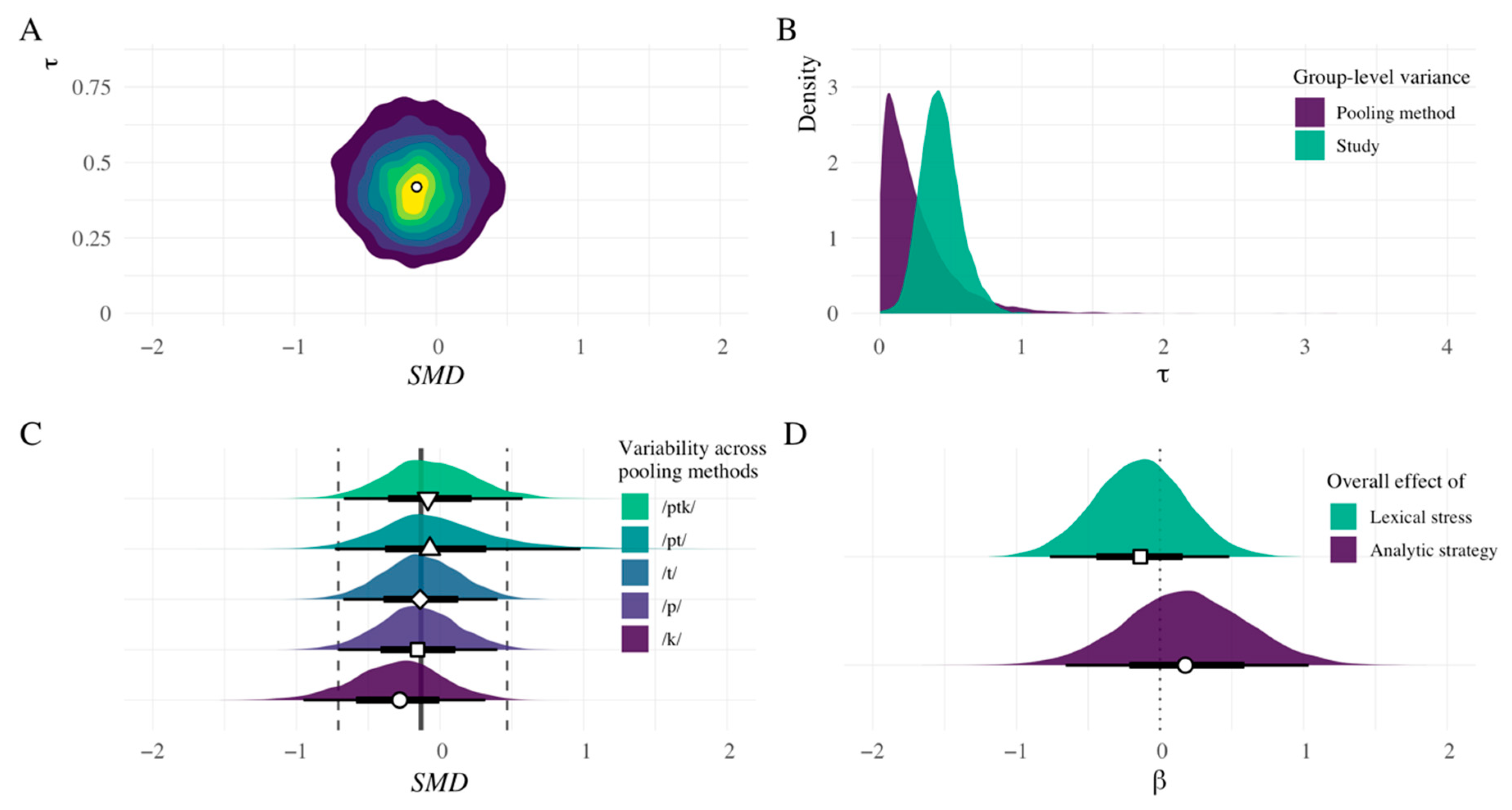
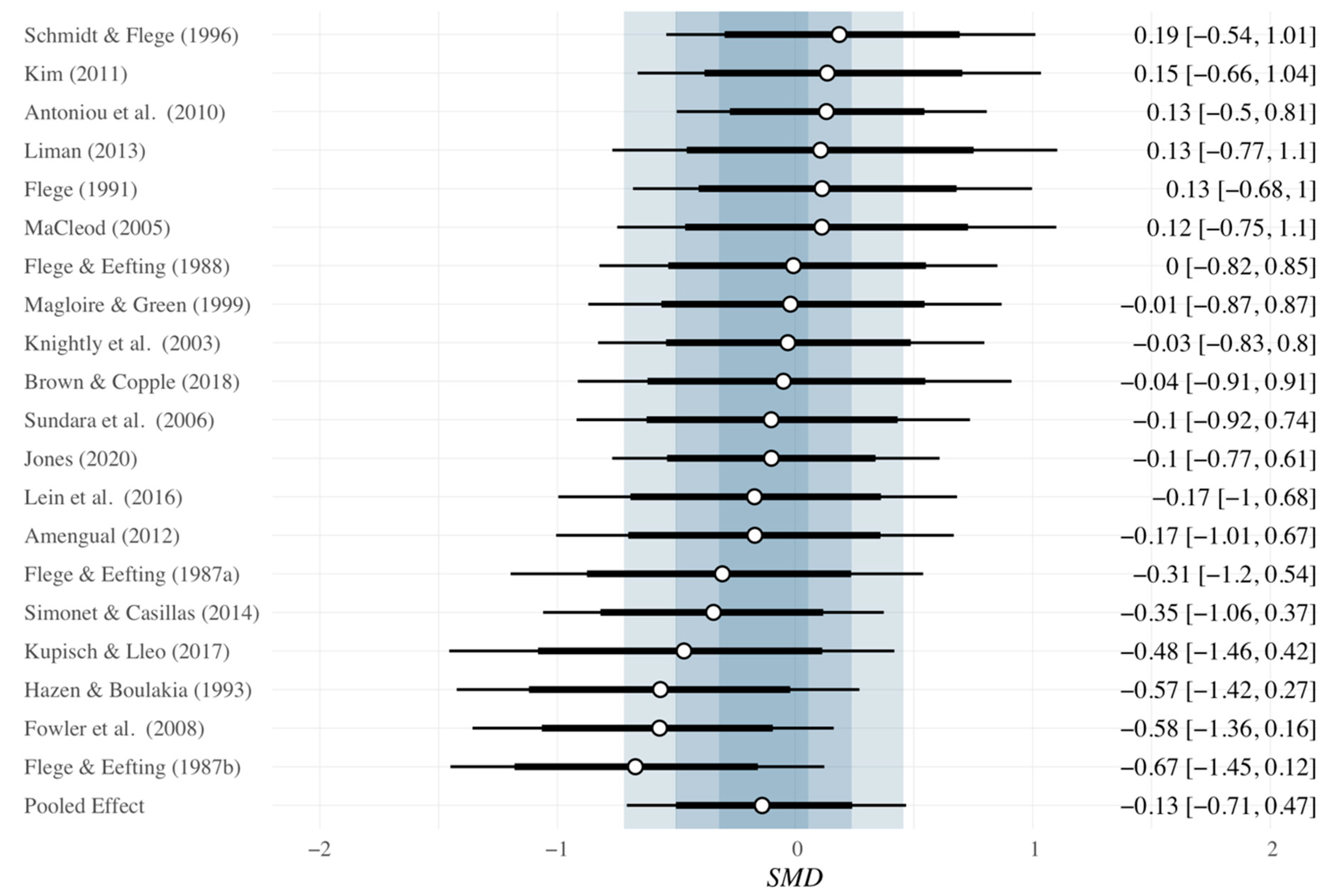
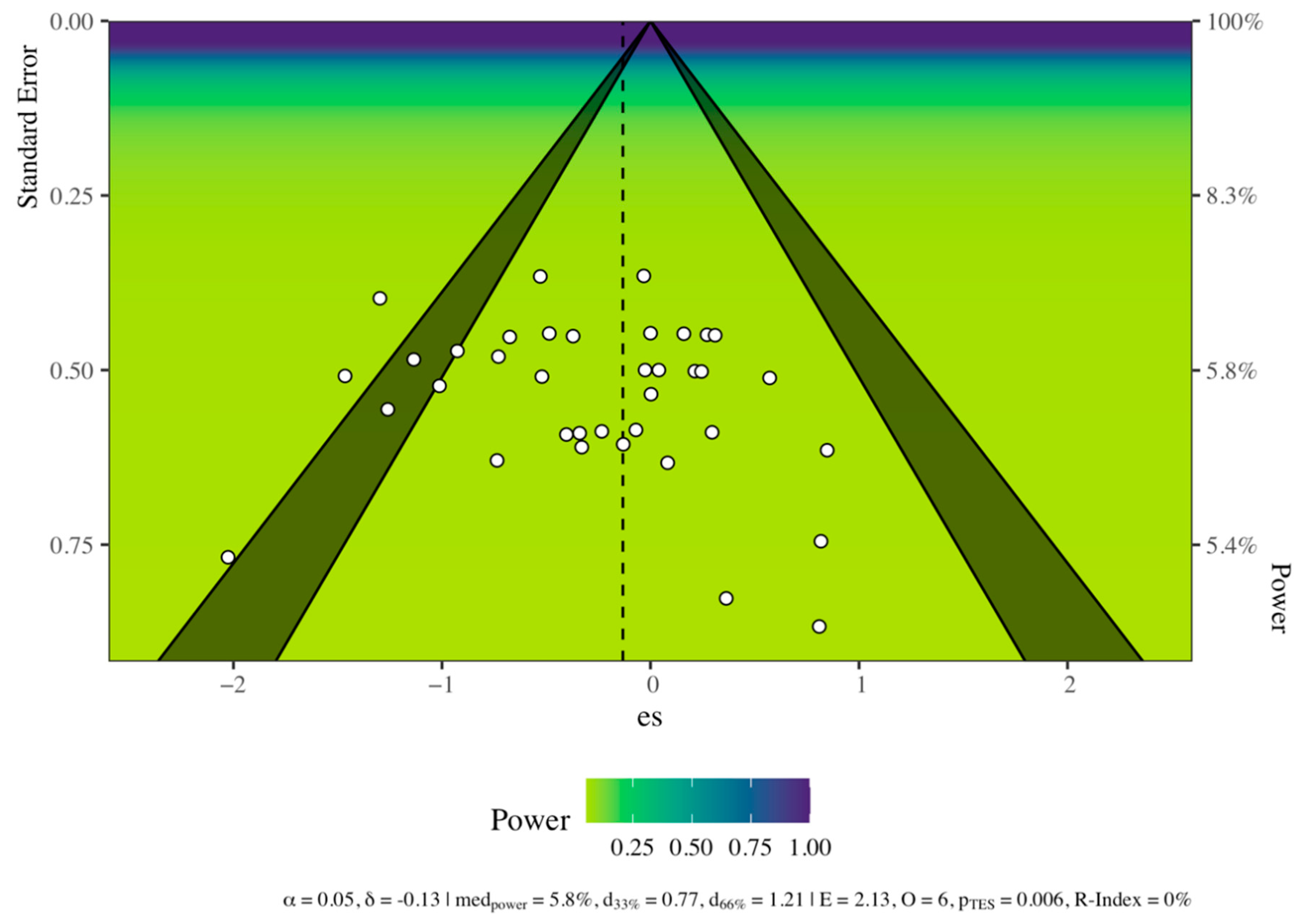
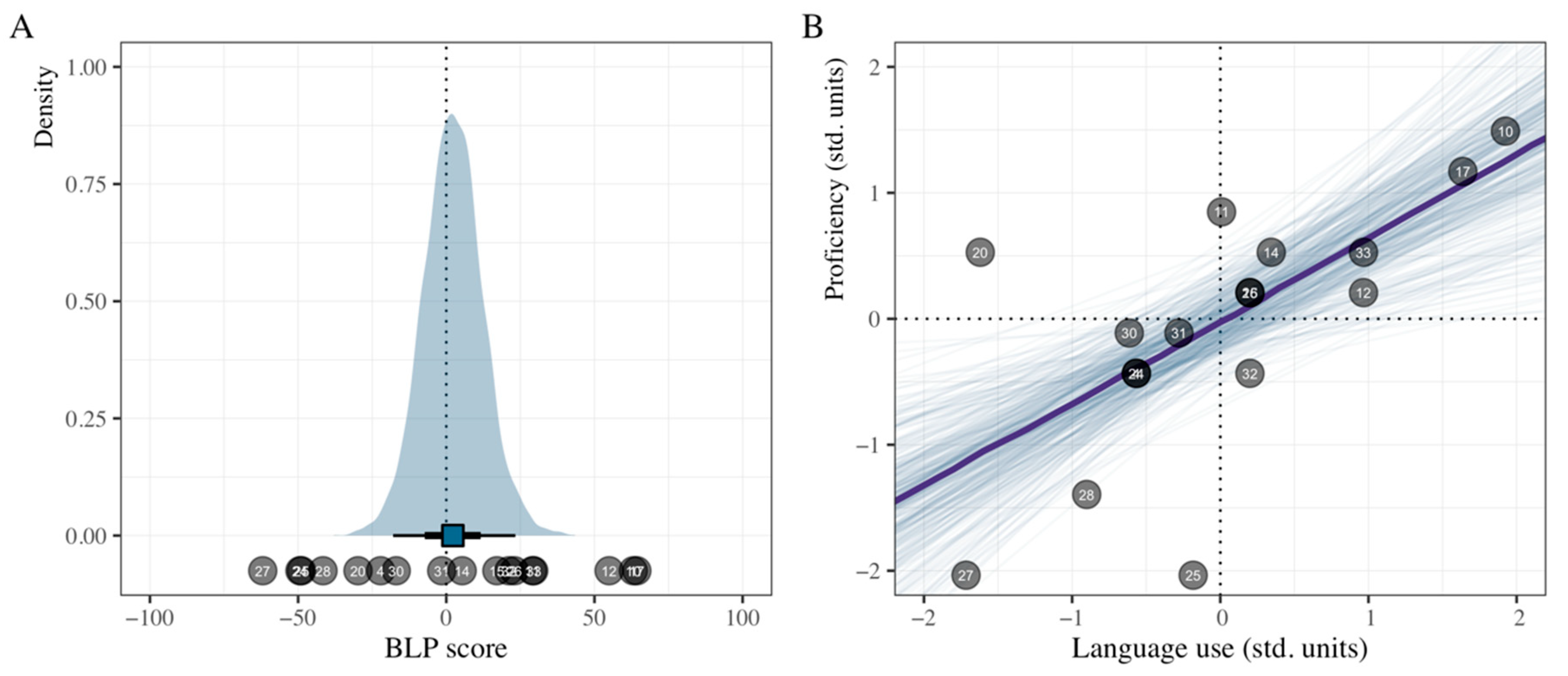
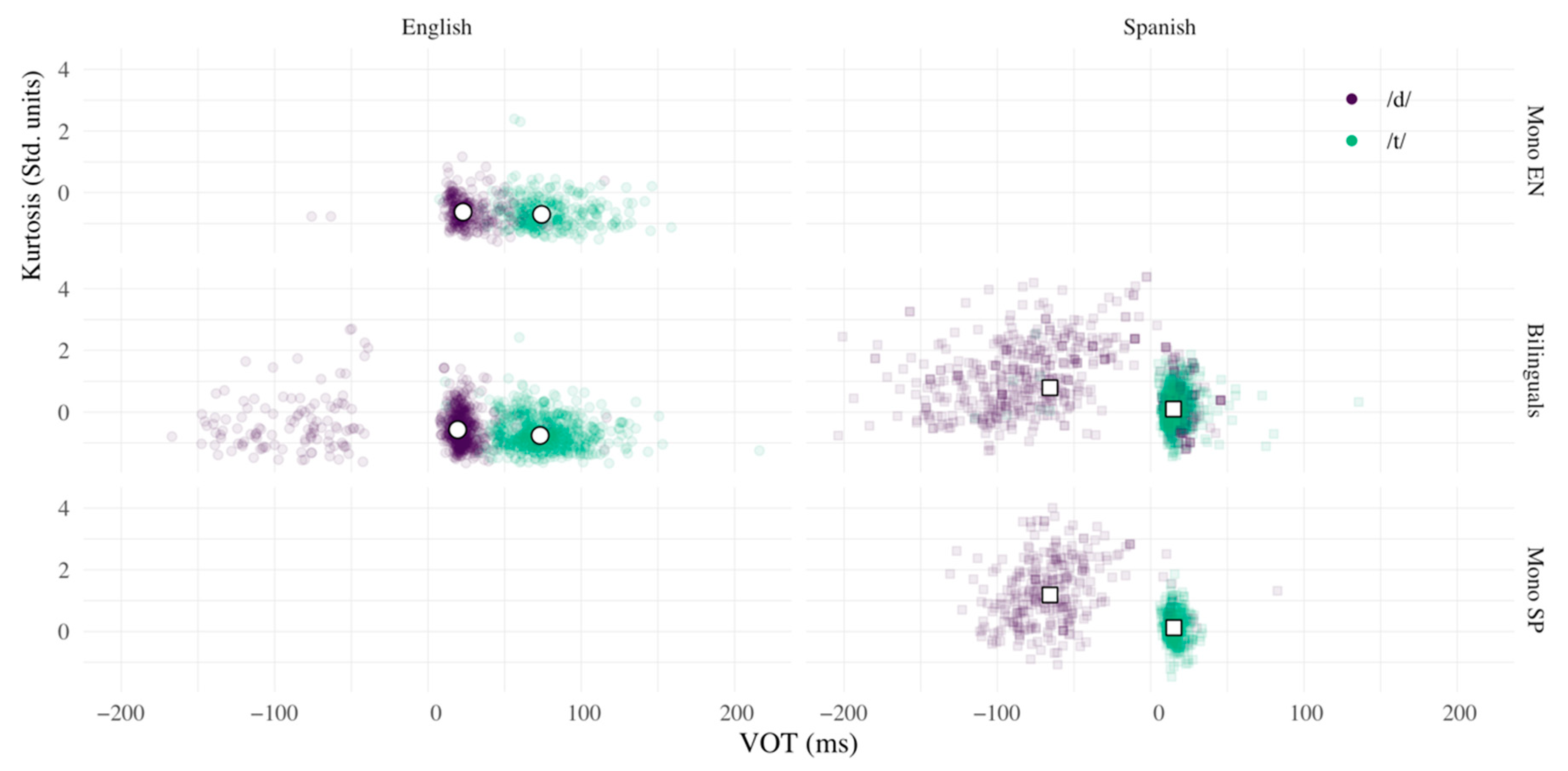
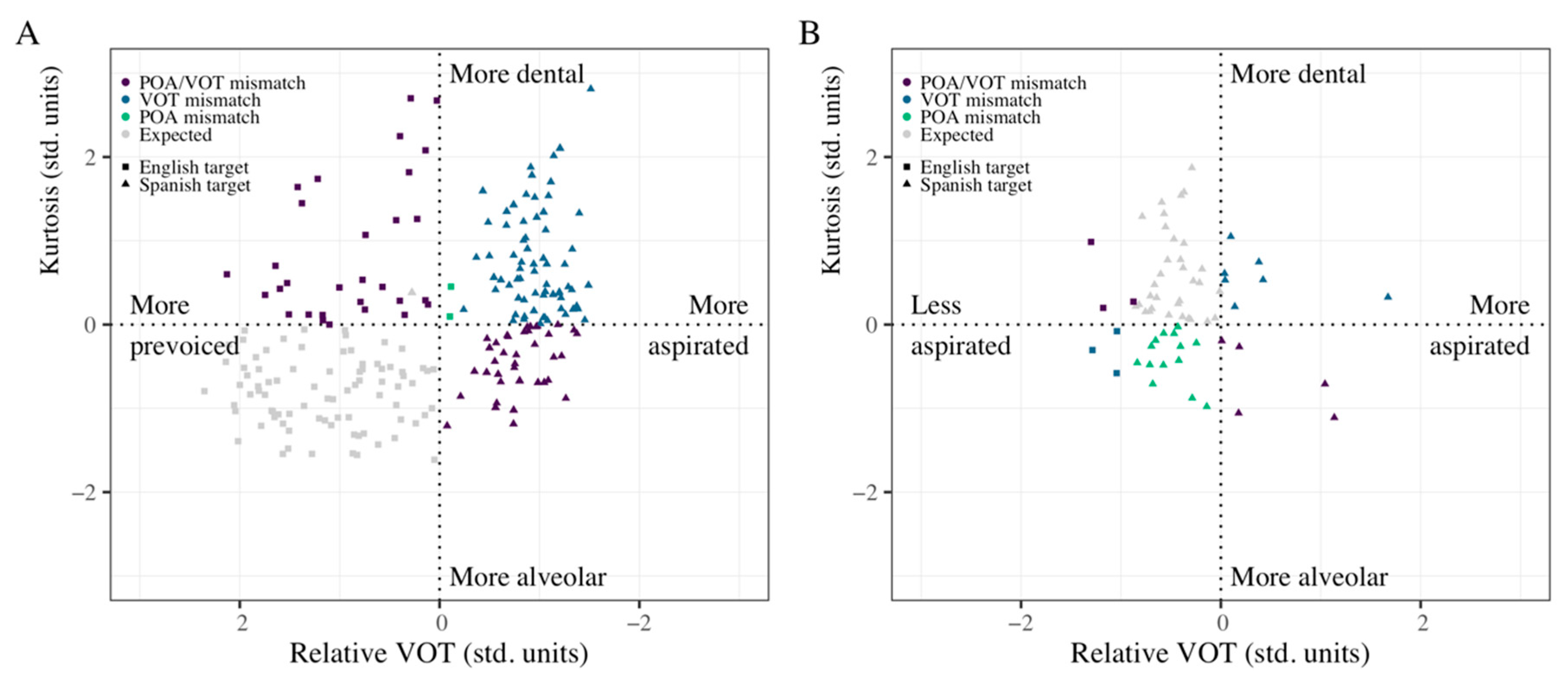
| Outcome | Language | Parameter | β | 95% HDI | MPE | ROPE % | ROPE |
|---|---|---|---|---|---|---|---|
| VOT | Spanish | Intercept | −23.19 | [−31.84, −14.89] | 1 | 0 | [−5.12, 5.12] |
| Group | 0.78 | [−6.98, 8.60] | 0.58 | 0.84 | [−5.12, 5.12] | ||
| Phon. | −38.87 | [−46.56, −31.77] | 1 | 0 | [−5.12, 5.12] | ||
| Item rep. | −1.02 | [−2.73, 0.68] | 0.89 | 1 | [−5.12, 5.12] | ||
| Group × Phon. | 1.21 | [−4.84, 8.06] | 0.65 | 0.89 | [−5.12, 5.12] | ||
| English | Intercept | 45.19 | [38.66, 51.81] | 1 | 0 | [−4.60, 4.60] | |
| Group | −7.00 | [−13.02, −0.95] | 0.98 | 0.19 | [−4.60, 4.60] | ||
| Phon. | −31.74 | [−37.77, −25.36] | 1 | 0 | [−4.60, 4.60] | ||
| Item rep. | −0.21 | [−1.57, 1.13] | 0.62 | 1 | [−4.60, 4.60] | ||
| Group × Phon. | −5.16 | [−11.02, 0.18] | 0.96 | 0.41 | [−4.60, 4.60] | ||
| Relative | Spanish | Intercept | 0.21 | [0.19, 0.23] | 1 | 0 | [−0.01, 0.01] |
| VOT | Group | −0.01 | [−0.02, 0.02] | 0.58 | 0.94 | [−0.01, 0.01] | |
| Phon. | 0.10 | [0.07, 0.13] | 1 | 0 | [−0.01, 0.01] | ||
| Item rep. | 0.01 | [−0.01, 0.01] | 0.83 | 1 | [−0.01, 0.01] | ||
| Group × Phon. | −0.01 | [−0.03, 0.02] | 0.66 | 0.79 | [−0.01, 0.01] | ||
| English | Intercept | 0.29 | [0.27, 0.31] | 1 | 0 | [−0.01, 0.01] | |
| Group | 0.01 | [−0.01, 0.02] | 0.69 | 0.89 | [−0.01, 0.01] | ||
| Phon. | −0.10 | [−0.12, −0.08] | 1 | 0 | [−0.01, 0.01] | ||
| Item rep. | −0.01 | [−0.01, 0.01] | 0.83 | 1 | [−0.01, 0.01] | ||
| Group × Phon. | 0.01 | [−0.01, 0.03] | 0.91 | 0.69 | [−0.01, 0.01] |
Publisher’s Note: MDPI stays neutral with regard to jurisdictional claims in published maps and institutional affiliations. |
© 2021 by the author. Licensee MDPI, Basel, Switzerland. This article is an open access article distributed under the terms and conditions of the Creative Commons Attribution (CC BY) license (http://creativecommons.org/licenses/by/4.0/).
Share and Cite
Casillas, J.V. Interlingual Interactions Elicit Performance Mismatches Not “Compromise” Categories in Early Bilinguals: Evidence from Meta-Analysis and Coronal Stops. Languages 2021, 6, 9. https://doi.org/10.3390/languages6010009
Casillas JV. Interlingual Interactions Elicit Performance Mismatches Not “Compromise” Categories in Early Bilinguals: Evidence from Meta-Analysis and Coronal Stops. Languages. 2021; 6(1):9. https://doi.org/10.3390/languages6010009
Chicago/Turabian StyleCasillas, Joseph V. 2021. "Interlingual Interactions Elicit Performance Mismatches Not “Compromise” Categories in Early Bilinguals: Evidence from Meta-Analysis and Coronal Stops" Languages 6, no. 1: 9. https://doi.org/10.3390/languages6010009





